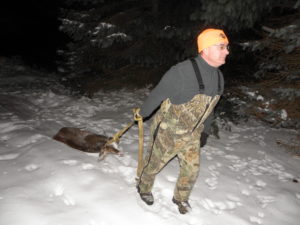By Glen Wunderlich
New Year’s Eve celebrations take on many forms but there is typically a common denominator: abundant wishes of all good things for the coming year. (Oh, and you thought the answer would have been adult beverages.) But, longtime pal and hunting partner, Joe Reynolds, bucked the time-honored tradition of dancing and horn tooting for one last chance at taking what had become an elusive late-season whitetail doe.
The generous deer seasons had combined for some 90 days already, and for various reasons along the way, Joe found himself getting serious on the final afternoon of 2017. Now, that doesn’t mean ol’ Joe was about to get unethical – just that he wasn’t about to pass on an adult doe; he also could not afford more mistakes, as explained below.
October 1st, opening afternoon of archery deer season, the veteran hunter was drooling over three respectable bucks a bit out of range for his Parker crossbow, when from cover stepped a worthy 9-point buck in range. As the archer attempted to get into position, the buck detected movement and vanished as fast as you can say “Poof!”
Fast forward to the final weekend of deer season in Shiawassee County – the final Saturday to be exact. Joe was toting his fine-shooting CVA muzzleloader, which had been readied a few weeks prior for Zone III muzzleloading season. Things were looking good, as a group of does ran onto the stage in front of him right in his wheelhouse near 100 yards. The long wait was over, as he squeezed the trigger on the chip shot; however, the modern muzzleloader omitted a feeble pop, as Joe literally watched the bullet fall harmlessly in the snow in front of him. That was that. A dud.
His last chance would be New Year’s Eve afternoon, but that morning he agreed to test my new Ruger American in .450 Bushmaster caliber in an effort to eliminate equipment failures. A target was placed precisely at 100 yards and the only shot taken punched the paper at 12 o’clock two inches high. Perfect.
On stand, Joe radioed to let me know several does had entered the field within range. Once again, a human blunder sent the deer to cover, and for the first time all season, Joe’s confidence was shaken. Heck, only 30 minutes remained in his season and the brassica field was vacant. Meanwhile, I kept an eye on the clock. Fifteen minutes, ten minutes, eight minutes, five minutes and then bang.
Joe radioed that the large doe targeted gave the unmistakable rear-leg kick – a sure sign of a well-placed shot – as it sped to the woods. Daylight turned to darkness, as we followed an easily identifiable blood trail to the expired animal in short order.

Joe Reynolds brings home the venison
The perfectly placed 250-grain Hornady Flex-Tip projectile was on the mark at 129 yards and there was nothing left to do but field dressing and muscling the prize to the garage. There, we would light a wood fire to keep the animal from freezing, as the temperature had already sunk to -6 degrees.
What remained of New Year’s Eve left ample time for celebrating the reward of persistence and yet another memorable deer season.









